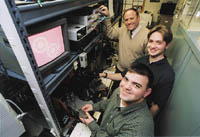| Articles:
From rock
to Bach

No big deal
By Nancy Bartosek

| Small
thinkers. Engineering
undergrads Matt Ruff (front) and Richard Wilks are helping Engineering
Prof. Ed Kolesar develop a microscopic motor that will one day be
attached to a lens in an artificial eye. Below are the engine and
gears, magnified thousands of times. The large black lines are tiny
wires that provide the electricity to the prototype. |

|

Slice a hair into 100 widths.
Take one of those slices, and you have
a micron -- about 15 atoms stacked. And that's the size of the motor Engineering
Prof. Ed Kolesar built to power movement in an artificial lens that may
one day be part of an artificial eye.
That microscopic machine can spin at more
than 10,000 rpm.
Mind boggling?
Not to Kolesar, who has been working with
MEMS, or microelectromechanical systems for more than 20 years now.
"We basically are just taking dimensions
usually measured in feet and reducing them to microns," he said. "It's
no new-fangled technology."
But TCU is the only university in Texas
taking the silicon devices to such extremes. Kolesar and his choice undergraduate
researchers design the machines in a TCU lab, then send them to a semiconductor
plant to be manufactured.
The same techniques used to create computer
chips are employed to build Kolesar's motors. Though the creation of a
viable artificial eye is still years away, the "muscles" that will move
the lens of that eye are already getting a workout in Kolesar's lab.
Top
|



